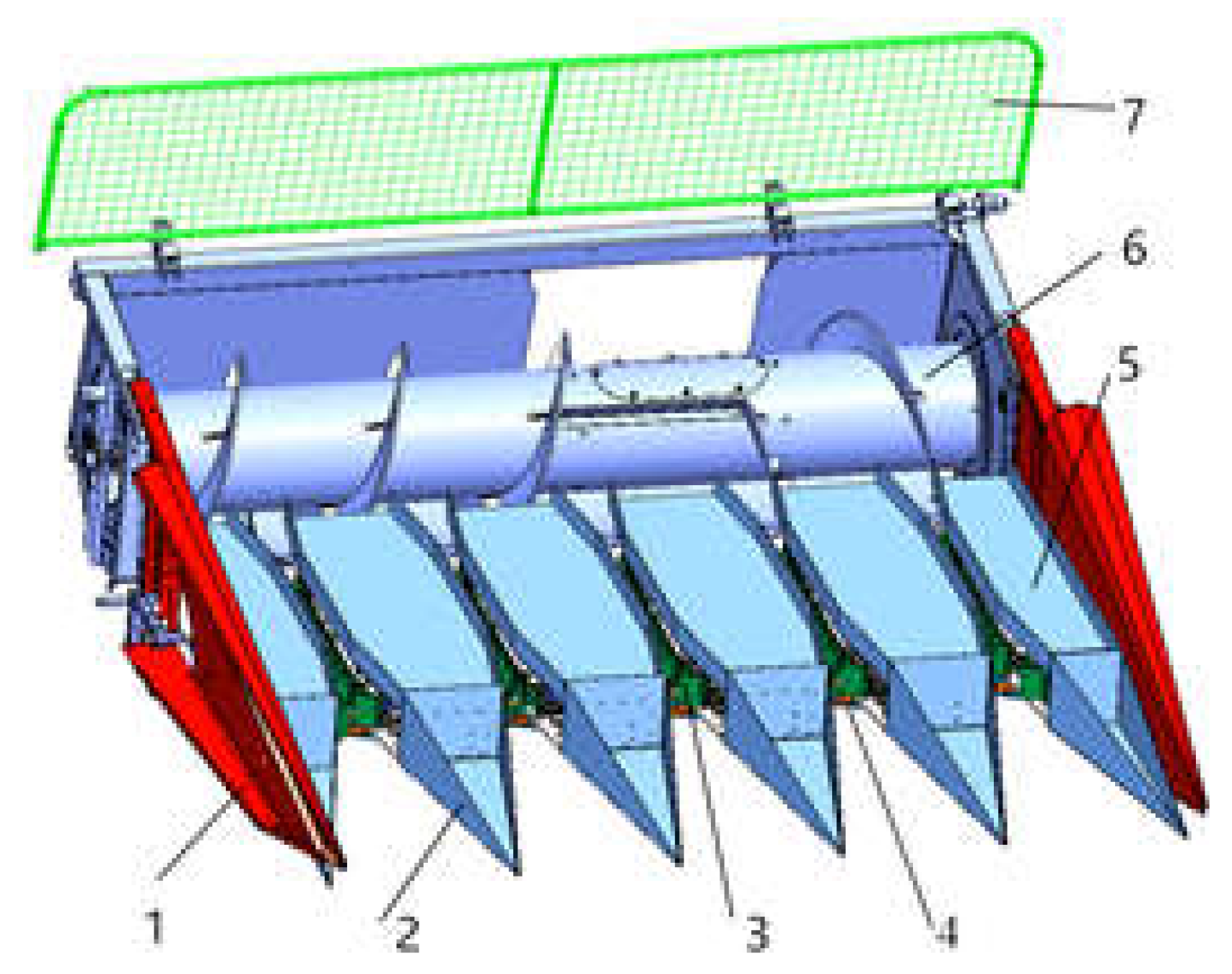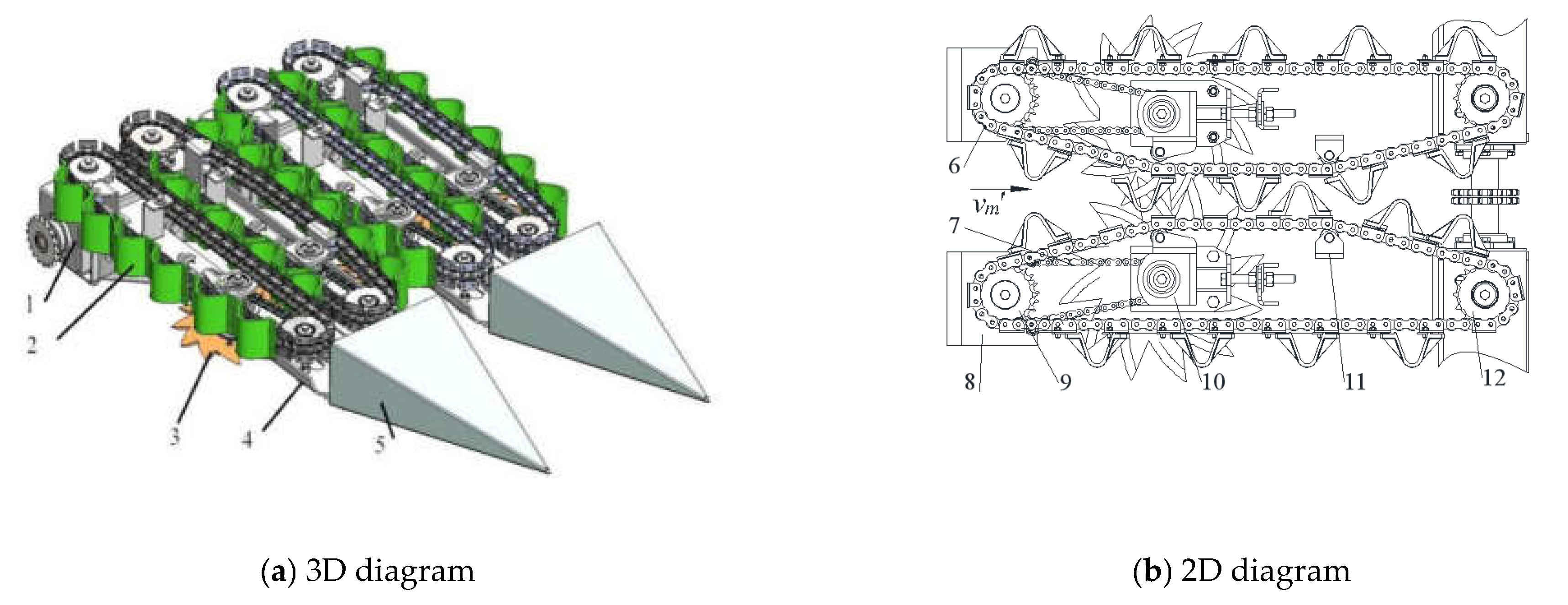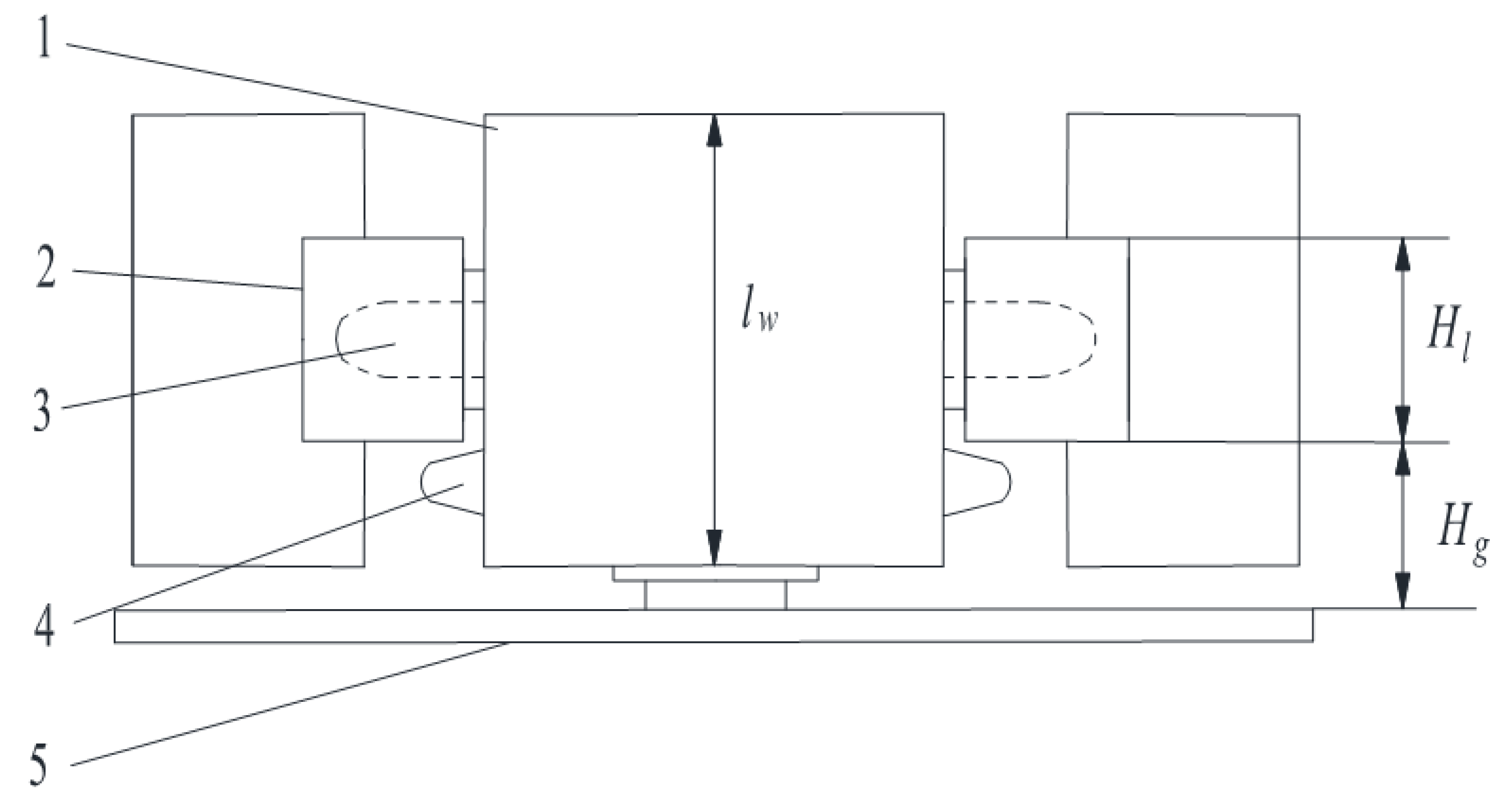Optimization of Clamping and Conveying Device for Sunflower Oil Combine Harvester Header
Abstract
:1. Introduction
2. Materials and Methods
2.1. Structural Design
2.2. Operation Principle
2.3. Design of the Key Parameters
2.3.1. The Design of Conveying Chain Parameters
Center Distance
The Front Inclination Angle of Chain
The Angle of Chain Rear Inclination
2.3.2. The Design of Clamping Element Parameters
Height of the Clamping Element
The Mounting Width of Clamping Element
The Width of Clamping Element
2.4. Principle Analysis of the Clamping
2.5. Methods and Materials of Bench Tests
2.5.1. Materials and Devices
2.5.2. Selection of Factor Parameters
- The Clamping Speed Ratio
- 2.
- The Clamping Gap
- 3.
- The Clamping Length
2.5.3. Appraisal Indexes
- The Conveying Success Rate
- 2.
- The Grain Loss Rate
3. Results and Discussion
3.1. Analysis of Single-Factor Test and Results
3.2. Analysis of Orthogonal Test Results
3.3. Parameter Optimization
3.4. Verification Tests
3.5. Contrast Test
4. Discussion
4.1. Effect of Clamping Gap on Conveying Success Rate and Grain Loss Rate
4.2. Effect of Clamping Speed Ratio on Conveying Success Rate and Grain Loss Rate
4.3. Effect of Clamping Length on Conveying Success Rate and Grain Loss Rate
5. Conclusions
- (1)
- To solve the problem of grain spatter during harvest by the combine harvester header, a new clamping and conveying device for the sunflower oil harvester header was designed.
- (2)
- The effects of the clamping gap, clamping speed ratio, and clamping length on the plant delivery success rate were investigated using the single-factor test. The results showed that the optimal clamping speed ratio range was 1.2–1.6, the optimal clamping gap range was 20–40 mm, and the optimal clamping length range was 250–450 mm.
- (3)
- The optimal parameter combination obtained by secondary regression orthogonal test was as follows: the optimal clamping gap was 20 mm, the optimal clamping speed ratio was 1.3, the optimal clamping length was 345 mm, the maximum plant conveying success rate was 85.16%; the minimum value of conveying grain loss rate was 1.57%. The verification result was close to the predicted value.
- (4)
- The comparison results indicated that the plant conveying success rate of the flexible clamping and conveying device was 83.50%, with a falling grain loss of 1.49%, and the plant conveying success rate of the rigid clamping and conveying device was 55%, with a falling grain loss of 5.17%, which suggested that the effect of the flexible clamping and conveying device was better.
6. Patent
Author Contributions
Funding
Institutional Review Board Statement
Informed Consent Statement
Data Availability Statement
Acknowledgments
Conflicts of Interest
References
- Nenko, N.I.; Neshchadim, N.N.; Yablonskay, E.K.; Sonin, K.E. Prospects for sunflower cultivation in the Krasnodar region with the use of plant growth regulator. Helia 2016, 39, 197–211. [Google Scholar] [CrossRef]
- Bukhsh, M.A.A.H.A.; Iqbal, J.; Kaleem, S.; Wasaya, A.; Ishaque, M. Qualitative analysis of spring planted sunflower hybrids as influenced by varying nutritional area. Pak. J. Nutr. 2011, 10, 291–295. [Google Scholar]
- Zong, W.; Liu, Y.; Huang, X. Present situation and development countermeasures of mechanized harvesting of sunflower. J. Jiangxi Agric. Univ. 2017, 39, 600–606. [Google Scholar]
- Pari, L.; Latterini, F.; Stefanoni, W. Herbaceous oil crops, a review on mechanical harvesting state of the art. Agriculture 2020, 10, 309. [Google Scholar] [CrossRef]
- Tomchuk, V. Loss management when harvesting grain, legume and oilseed crops. Nor. J. Dev. Int. Sci. 2020, 1, 54–67. [Google Scholar]
- Jiang, Y.; Wen, Y.; Xu, J. Study on the main working components of tremella rice Joint receiver before cutting. Trans. Chin. Soc. Agric. Mach. 1981, 3, 53–67. [Google Scholar]
- Liang, S.; Jin, C.; Zhang, F.; Kang, D.; Hu, M. Design and experiment of 4LZG-3.0 millet combine harvester. Trans. Chin. Soc. Agric. Eng. Trans. CSAE 2015, 31, 31–38. [Google Scholar]
- Hachiya, M.; Amano, T.; Yamagata, M. Development and utilization of a new mechanized cabbage harvesting system for large Fields. Jpn. Agric. Res. Q. JARQ 2004, 38, 97–103. [Google Scholar] [CrossRef] [Green Version]
- Splinter, F.S.W.E. Development of a mechanical cabbage harvester. Trans. ASAE 1966, 9, 862–865. [Google Scholar] [CrossRef]
- Cui, T.; Fan, C.; Zhang, D.; Yang, L.; Li, Y.; Zhao, H. Research progress of maize mechanized harvesting technology. Trans. Chin. Soc. Agric. Mach. 2019, 50, 1–13, (In Chinese with English abstract). [Google Scholar]
- Geng, D.; Zhang, D.; Li, Q.; Diao, P. Experimental study on technical parameters of raking and conveying device of corn harvester. Trans. Chin. Soc. Agric. Eng. Trans. CSAE 2012, 28, 45–49. [Google Scholar]
- Kang, T.H.; Kaizu, Y. Vibration analysis during grass harvesting according to iso vibration standards. Comput. Electron. Agric. 2011, 79, 226–235. [Google Scholar] [CrossRef] [Green Version]
- Du, D.; Fei, G.; Wang, G.; Wang, J.; Huang, J.; You, X. Development and experiment of self-propelled cabbage harvester. Trans. Chin. Soc. Agric. Eng. Trans. CSAE 2015, 31, 16–23. [Google Scholar]
- Du, D.; Wang, J.; Qiu, S. Analysis and test of splitting failure in the cutting process of cabbage root. Int. J. Agric. Biol. Eng. 2015, 8, 27–34. [Google Scholar]
- Hiroki, S.; To, S.; Nao, S.; Yui, C.; Nobuyo, S. Accurate position detecting during asparagus Spear harvesting using a laser sensor. Eng. Agric. Environ. Food 2013, 6, 105–110. [Google Scholar]
- Zhang, Z.; Han, Z.; Liu, L.; Li, X.; Hao, F.; Dong, Z. Parameters optimization for gripping and delivering device of corn harvester for reaping both corn stalk and spike. Trans. Chin. Soc. Agric. Mach. 2018, 49, 114–121. [Google Scholar]
- Geng, D.; Li, Y.; He, K.; Jin, C.; Ni, G.; Zhang, M. Design and experiment on gripping delivery mechanism for vertical-rollers type of corn harvest-er. Trans. Chin. Soc. Agric. Mach. 2017, 48, 130–136. [Google Scholar]
- Yang, R.; Shang, S. Test analysis of peanut combine flexible clamping device. Trans. Chin. Soc. Agric. Mach. 2018, 41, 67–70. [Google Scholar]
- Startsev, A.S.; Demin, E.E.; Danilin, A.V.; Vasilyev, O.A.; Terentyev, A.G. Results of the production test of sunflower harvesting attachment with an auger reel. In IOP Conference Series: Earth and Environmental Science; IOP Science: Cheboksary, Russia, 2020; Volume 433, p. 012006. [Google Scholar]
- Dahab, M.H.; Elsheikh, A.O. Quantitative Losses of Sunflower Combine Harvesting as Affected by Machine Header Modification, Forward Speed and Crop Seed Moisture Content. Univ. Khartoum J. Agric. Sci. Sudan 2004, 11, 179–203. [Google Scholar]
- Ghiasi, P.; Safari, M. Modeling Grain Losses in Mechanized Harvesting of Oily Sunflower. J. Agric. Mach. 2021, 11, 399–408. [Google Scholar]
- Li, Y.; Yi, Y.; Du, S.; Ding, Q.; Ding, W. Design and experiment on air blowing header of plot combine harvester for grain. Trans. Chin. Soc. Agric. Mach. 2017, 48, 79–87. [Google Scholar]
- Guo, C.; Guo, R.; Zhao, X. Analysis of plate header parameters of corn harvester. J. Shanxi Agric. Univ. Nat. Sci. Ed. 2011, 31, 377–380. [Google Scholar]
- Li, Q.; Gao, D.; Deng, H. Closure of contact force of heavy load gripper. J. Mech. Eng. 2010, 46, 36–42. [Google Scholar] [CrossRef]
- Ye, M.; Zou, X.; Yang, Z. Clamping Experiment on Humanoid Fingers of Litchi Harvesting Robot. Trans. Chin. Soc. Agric. Machinery 2015, 46, 1–8. [Google Scholar]
- Yu, Z.; Hu, Z.; Wang, H.; Bao, L. Parameters optimization and experiment of garlic picking mechanism. Trans. Chin. Soc. Agric. Eng. Trans. CSAE 2015, 31, 40–46. [Google Scholar]
- Xu, L.; Liu, X.; Zhang, K.; Xing, J.; Yuan, Q.; Chen, J.; Duan, Z.; Ma, S.; Yu, C. Design and test of end-effector for navel orange picking robot. Trans. Chin. Soc. Agric. Eng. Trans. CSAE 2018, 34, 53–61. [Google Scholar]
- Wang, F.; Sun, G.; Shang, S. Development of 4CL-1 self-propelled combine harvester for green onion. Trans. Chin. Soc. Agric. Eng. Trans. CSAE 2019, 35, 39–47. [Google Scholar]
- Wang, G.; Jia, H.; Zhao, J. Design of corn high-stubble cutter and experiments of stubble retaining effects. Trans. Chin. Soc. Agric. Eng. Trans. CSAE 2014, 30, 43–49. [Google Scholar]
- Li, Z.; Malik, O.P. An orthogonal test approach based control parameter optimization and its application to a hydro-turbine governor. IEEE Trans. Energy Convers. 1997, 12, 388–393. [Google Scholar]
- Isaac, N.E.; Quick, G.R.; Birrell, S.J. Combine Harvester Econometric Model with Forward Speed Optimization. Appl. Eng. Agric. 2006, 22, 308–323. [Google Scholar] [CrossRef] [Green Version]
- El-Shekeil, Y.A.; Sapuan, S.M.; Haron, M. Optimization of Processing Parameters and Fiber Content of Cocoa Pod Husk Fiber-Reinforced Thermoplastic Polyurethane Composites by Taguchi Method. Appl. Mech. Mater. 2014, 564, 394–399. [Google Scholar] [CrossRef]









| Parameter | Numerical Value |
|---|---|
| Vertical height, h/mm | 452–1965 |
| Average thickness of sunflower disk, m/mm | 22.7 |
| Average diameter of sunflower, D/mm | 156.5 |
| Critical bending angle of stem, α/° | 17.93–55.49 |
| Moisture content of stem, w1/% | 55.3~84.5 |
| Grain moisture content, w0/% | 25~35 |
| Level | Experimental Factor | ||
|---|---|---|---|
| Clamping Gap x1/mm | Clamping Speed Ratio x2 | Clamping Length x3/mm | |
| −1 | 20 | 1.2 | 250 |
| 0 | 30 | 1.4 | 350 |
| 1 | 40 | 1.6 | 450 |
| No | Clamping Gap x1/mm | Clamping Speed Ratio x2 | Clamping Length x3/mm | Plant Conveying Success Rate Y1/% | Grain Loss Rate Y2/% |
|---|---|---|---|---|---|
| 1 | 20 | 1.2 | 350 | 87.50 | 1.75 |
| 2 | 40 | 1.2 | 350 | 68.33 | 2.33 |
| 3 | 20 | 1.6 | 350 | 81.67 | 1.98 |
| 4 | 40 | 1.6 | 350 | 72.50 | 3.13 |
| 5 | 20 | 1.4 | 250 | 80.00 | 1.25 |
| 6 | 40 | 1.4 | 250 | 69.17 | 3.67 |
| 7 | 20 | 1.4 | 450 | 85.00 | 3.83 |
| 8 | 40 | 1.4 | 450 | 77.50 | 3.06 |
| 9 | 30 | 1.2 | 250 | 69.17 | 1.52 |
| 10 | 30 | 1.6 | 250 | 75.00 | 3.21 |
| 11 | 30 | 1.2 | 450 | 82.50 | 3.31 |
| 12 | 30 | 1.6 | 450 | 82.50 | 3.21 |
| 13 | 30 | 1.4 | 350 | 77.50 | 2.15 |
| 14 | 30 | 1.4 | 350 | 83.33 | 1.83 |
| 15 | 30 | 1.4 | 350 | 80.00 | 1.26 |
| 16 | 30 | 1.4 | 350 | 80.00 | 1.74 |
| 17 | 30 | 1.4 | 350 | 77.50 | 1.96 |
| Variance Source | Free Degree | Sum of Squares of Deviations | Mean Square | F Value | p Value | ||||
|---|---|---|---|---|---|---|---|---|---|
| Conveying Success rate/% | Grain Loss Rate/% | Conveying Success Rate/% | Grain Loss Rate/% | Conveying Success Rate/% | Grain Loss Rate/% | Conveying Success Rate/% | Grain Loss Rate/% | ||
| Model | 9 | 472.883 | 0.001129 | 52.543 | 0.000125 | 7.42 | 18.01 | 0.008 | 0.001 |
| Linear | 3 | 420.298 | 0.000405 | 140.099 | 0.000135 | 19.77 | 19.4 | 0.001 | 0.001 |
| x1 | 1 | 272.261 | 0.000143 | 272.261 | 0.000143 | 38.42 | 20.5 | 0.001 | 0.002 |
| x2 | 1 | 2.174 | 0.000086 | 2.174 | 0.000086 | 0.31 | 12.32 | 0.597 | 0.009 |
| x3 | 1 | 145.863 | 0.000177 | 145.863 | 0.000177 | 20.59 | 25.37 | 0.003 | 0.001 |
| Square | 3 | 16.316 | 0.000381 | 5.439 | 0.000127 | 0.77 | 18.22 | 0.548 | 0.001 |
| x12 | 1 | 2.5 | 0.000044 | 2.5 | 0.000044 | 0.35 | 6.38 | 0.571 | 0.04 |
| x22 | 1 | 8.2 | 0.000014 | 8.2 | 0.000014 | 1.16 | 2.06 | 0.318 | 0.194 |
| x32 | 1 | 4.027 | 0.000297 | 4.027 | 0.000297 | 0.57 | 42.63 | 0.475 | 0.004 |
| Interaction | 3 | 36.269 | 0.000343 | 12.09 | 0.000114 | 1.71 | 16.4 | 0.252 | 0.002 |
| x1x2 | 1 | 25 | 0.000008 | 25 | 0.000008 | 3.53 | 1.17 | 0.102 | 0.316 |
| x1x3 | 1 | 2.772 | 0.000254 | 2.772 | 0.000254 | 0.39 | 36.53 | 0.551 | 0.001 |
| x2x3 | 1 | 8.497 | 0.00008 | 8.497 | 0.00008 | 1.2 | 11.5 | 0.31 | 0.012 |
| Error | 7 | 49.6 | 0.000049 | 7.086 | 0.000007 | ||||
| Misfit | 3 | 26.569 | 0.000004 | 8.856 | 0.000001 | 1.54 | 0.13 | 0.335 | 0.936 |
| Amount to | 4 | 23.031 | 0.000044 | 5.758 | 0.000011 | ||||
| Model | 16 | 522.483 | 0.001177 | ||||||
| Project | Actual Value | Predicted Value | Error | |||
|---|---|---|---|---|---|---|
| 1 | 2 | 3 | Average | |||
| Conveying success rate | 82.50% | 85.50% | 82.50% | 83.50% | 85.16% | 1.95% |
| Grain loss rate | 1.24% | 1.56% | 1.68% | 1.49% | 1.57% | 5.1% |
| Project | Conveying Success Rate | Grain Loss Rate | ||||||
|---|---|---|---|---|---|---|---|---|
| 1 | 2 | 3 | Average | 1 | 2 | 3 | Average | |
| Rigid conveying chain | 65% | 55% | 45% | 55% | 5.40% | 5.60% | 4.50% | 5.17% |
| Flexible conveying chain | 82.50% | 85.50% | 82.50% | 83.50% | 1.24% | 1.56% | 1.68% | 1.49% |
Publisher’s Note: MDPI stays neutral with regard to jurisdictional claims in published maps and institutional affiliations. |
© 2021 by the authors. Licensee MDPI, Basel, Switzerland. This article is an open access article distributed under the terms and conditions of the Creative Commons Attribution (CC BY) license (https://creativecommons.org/licenses/by/4.0/).
Share and Cite
Liu, Y.; Luo, C.; Zong, W.; Huang, X.; Ma, L.; Lian, G. Optimization of Clamping and Conveying Device for Sunflower Oil Combine Harvester Header. Agriculture 2021, 11, 859. https://doi.org/10.3390/agriculture11090859
Liu Y, Luo C, Zong W, Huang X, Ma L, Lian G. Optimization of Clamping and Conveying Device for Sunflower Oil Combine Harvester Header. Agriculture. 2021; 11(9):859. https://doi.org/10.3390/agriculture11090859
Chicago/Turabian StyleLiu, Yang, Chengming Luo, Wangyuan Zong, Xiaomao Huang, Lina Ma, and Guodang Lian. 2021. "Optimization of Clamping and Conveying Device for Sunflower Oil Combine Harvester Header" Agriculture 11, no. 9: 859. https://doi.org/10.3390/agriculture11090859






